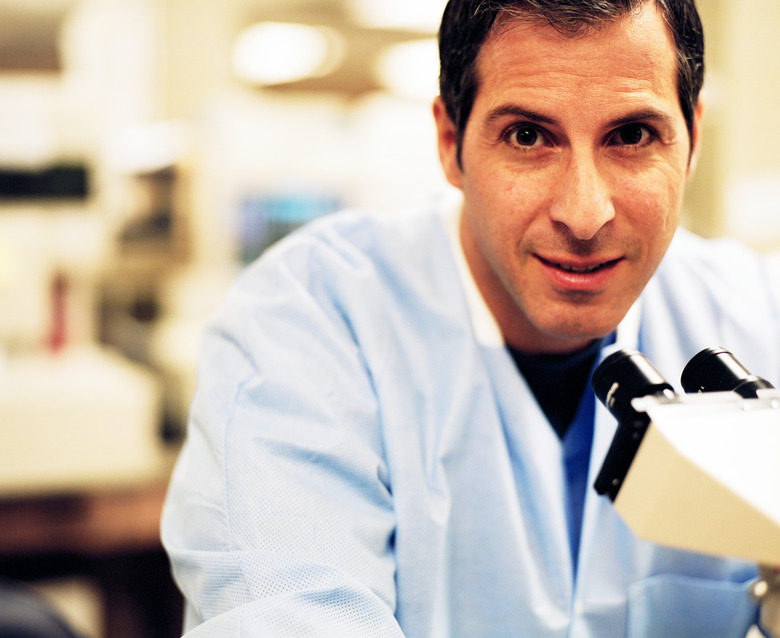How To Count Cells With A Microscope
Cells are the smallest and simplest structures that manifest all of the traits scientists agree signify "life." These qualities include merely having a physical structure, a means of reproducing, a set of well-defined metabolic pathways and so on. The discovery of cells in the late 17th century thanks to early microscopes and subsequent advancements in technology and microbiology have allowed for the close physical examination of cells, both singly and in groups.
As a student of science, you may find yourself in the position of having to count cells under a microscope for one reason or another. These might be red blood cells, or bacterial cells, or some other kind of cell or (commonly) a mixture of cell types. Can you think of any reasons that it might be important for health professionals to know such information at key times?
What Are Cells?
What Are Cells?
Cells contain a minimum of four elements: DNA (deoxyribonucleic acid), which serves as the parent organism's genetic material; a cell membrane as an outside boundary; cytoplasm, a watery gel filling most of the interior; and ribosomes for manufacturing proteins. Some cells have little more than this, and many organisms are made of only a single cell; the overwhelming majority of these unicellular organisms are **prokaryotes.**
The top-level classification domain Prokaryota includes bacteria and the set of organisms once called archaebacteria (Archaea). Many of these cells have walls and from colonies, making them easy to tell from eukaryotic cells on microscopy. Eukaryota (animals, plants and fungi) have cells that have **organelles,** internal membrane-bound structures such as mitochondria and chloroplasts.
Why Count Cell Density?
Why Count Cell Density?
It is important in a variety of setting to know if certain microorganisms are present in something, and if so, at what density. This enables microbiologists to know not only whether a given disease-causing microbial cell is contained in a sample being examined under a microscope, but how numerous they are and whether their number is increasing or decreasing.
This can be especially important in the area of public health, where official policies determine the extent to which providers in agricultural sectors (e.g., dairy and beef) have to provide low-bacteria products.
Types of Microscopes
Types of Microscopes
The most common microscope you will encounter in a lab setting is the compound microscope. This is a light microscope featuring two "stacked" magnifying lenses that offers high magnification but low resolution. It is therefore good for looking at individual cells, but not groups of cells. A dissection or stereoscopic microscope offers the opposite: low magnification but high resolution.
Either of these could be suitable for a counting experiment or exercise, depending on the slide of the cells being looked at and the magnification level required to get a useful visual field under the microscope lens(es).
Cell Counting Methods
Cell Counting Methods
Any cell counting calculation in the area of counting cells that are microorganisms will involve very tiny dilutions and very high numbers of organisms in a given sample. You can expect to see and use scientific notation (that is, exponents) in your reading and pertinent calculations.
The common methods of counting these kinds of cells are a plate count, which uses the growth of colonies that arise from bacterial cells in the sample to estimate the number of viable organisms in the visual field; a direct cell count, which requires various basic geometric and algebraic calculations; and **turbidity,** which uses how impenetrable to light a sample is as an estimate of bacterial growth in that sample.
Preparing a Microscope Counting Chamber
Preparing a Microscope Counting Chamber
You may be fortunate enough to come across an automatic cell counter called a hemocytometer (so named because it was originally meant for blood samples only). These make the work of counting cells using a microscope far easier, but care, as always, must be taken to clean the internal parts of the machinery before every use to ensure utmost accuracy.
Cite This Article
MLA
Beck, Kevin. "How To Count Cells With A Microscope" sciencing.com, https://www.sciencing.com/count-cells-microscope-5949561/. 31 July 2019.
APA
Beck, Kevin. (2019, July 31). How To Count Cells With A Microscope. sciencing.com. Retrieved from https://www.sciencing.com/count-cells-microscope-5949561/
Chicago
Beck, Kevin. How To Count Cells With A Microscope last modified August 30, 2022. https://www.sciencing.com/count-cells-microscope-5949561/
